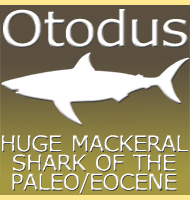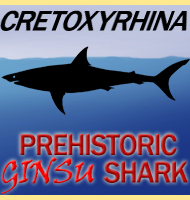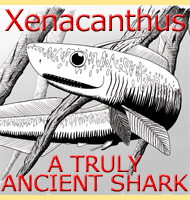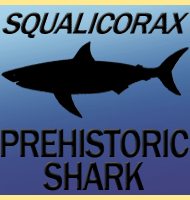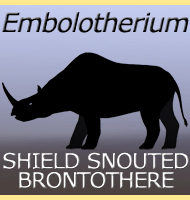


Carcharodon hubbelli
a.k.a. Hubbell’s white shark
Name:
Carcharodon hubbelli.
Phonetic: Car-kah-ro-don hub-bel-li.
Named By: D. J. Ehret, B. J. MacFadden,
D. S. Jones, T. J. DeVries, D. A. Foster &
R. Salas-Gismondi. 2012.
Classification: Chordata, Chondrichthyes,
Elasmobranchii, Lamniformes, Lamnidae, Carcharodon.
Species: C. hubbelli.
Diet: Carnivore/Piscivore.
Size: Unavailable.
Known locations: Peru - Piscoe Formation.
Time period: Messinian of the Miocene.
Fossil representation: Complete set of jaws
including 222 teeth. 45 vertebrae.
First
discovered by a Peruvian farmer in 1988, the holotype remains of
Carcharodon hubbelli were subsequently acquired by a
collector named
Gordon Hubbel. Over twenty years later in December 2009, Hubbel
donated the remains to the University of Florida. An initial
description of the remains was subsequently written up, but the
problem with this study was that the age estimate of the Piscoe
Formation from where the remains were recovered was questionable.
Using maps drawn up by Hubbel, a research team located the site of
the original discovery in Peru and then by a process of strontium
isotope testing determined the true age of the Piscoe Formation. This
saw the age estimate for the remains change from Pliocene to earlier
Late Miocene in age. In 2012 a more complete study (Ehret et
al) was published formally describing the remains as a new
species of
the Carcharodon genus. The species name C.
hubbelli
was in honour
of the collector and donator of the remains Gordon Hubbel.
As
a new species of the Carcharodon genus Carcharodon
hubbelli was in
essence an extinct relative of the famous modern day great white
shark, Carcharodon carcharias. More than this
though the teeth of
Carcharodon hubbelli are not just similar to those
of the great white
shark, they are also similar to those of broad toothed mako sharks of
the Isurus genus. The transitional form of the
teeth of Carcharodon
hubbelli therefore seems to suggest that great white shark
has its
ancestry stemming from mako sharks. It should be realised though that
Carcharodon hubbelli is not yet a perfect fit for
this lineage. The
type remains of Carcharodon hubbelli are late
Miocene in age, roughly
just over five to seven million years old. Great white shark fossils
by contrast are known to go back to the mid Miocene some sixteen
million years ago. However this observation in itself does not
detract from the significance of the discovery, since the first
individual Carcharodon hubbelli known to us may
have been from a late
surviving population. After all it is quite common for some overlap,
even by millions of years to exist amongst related forms.
If
the interpretation of Carcharodon hubbelli is
correct and the great
white sharks evolved from makos, then this would effectively clear
up one of the biggest debates in shark palaeontology which has lasted
for some one hundred and fifty years. This is the idea that the
modern day great white shark was descended from the infamous
‘megatoothed sharks’, such as the monstrous C.
megalodon. For
a long time the megatoothed sharks were included within the Carcharodon
genus but a few other researchers kept on pointing out key differences
between the shape and form of the megatoothed shark teeth, and those
of the great white. Eventually these researchers established a new
genus name, Carcharocles, to house megatoothed
shark species,
including C. megalodon, C.
angustidens, C.
chubutensis and
C.
auriculatus. Others however kept on insisting
that the original
interpretation of the megatoothed sharks should be within Carcharodon,
and so decades of debate and confusion as both genera were used
ensued. We are however fairly certain that mako sharks were separate
from the megatoothed sharks, and if a lineage between makos and the
modern great whites can be firmly established, then this would
actually validate the Carcharocles genus and the
inclusion of
megatoothed sharks within in it.
Carcharodon
hubbelli is known by fairly well preserved complete
remains
including teeth and vertebrae. This is significant in itself because
ninety-nine per cent of the time, fossil sharks are only represented
by teeth. Vertebrae are occasionally found since the cartilage that
originally makes them up is usually more ossified and therefore more
likely to survive until fossilisation. Even rarer than this are soft
tissue preservations such as impressions upon the rocks surrounding
teeth and vertebrae.
Further reading
- Origin of the white shark Carcharodon
(Lamniformes: Lamnidae)
based on recalibration of the upper Neogene Pisco Formation of Peru
- Palaeontology 55(6):1139-1153 - D. J. Ehret, B.
J. MacFadden, D. S. Jones, T. J. DeVries, D. A.
Foster & R. Salas-Gismondi. 2012.
----------------------------------------------------------------------------
Random favourites
 |
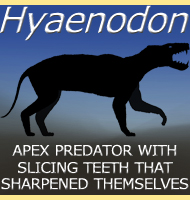 |
 |
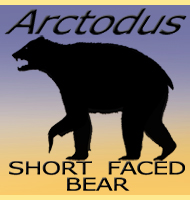 |
